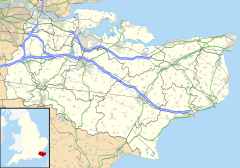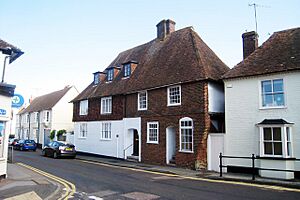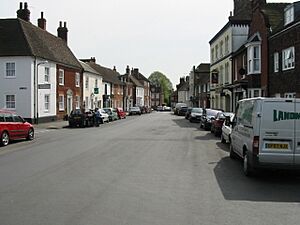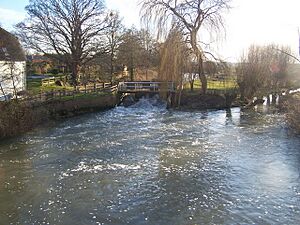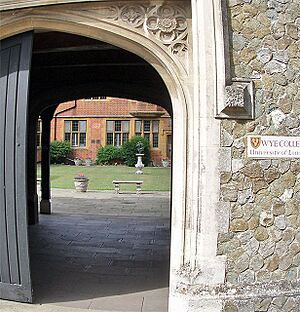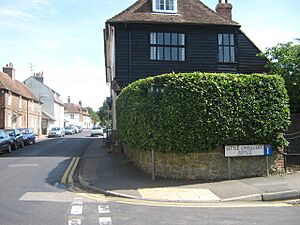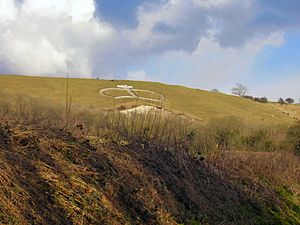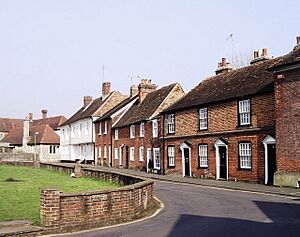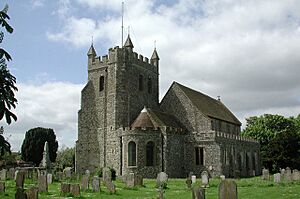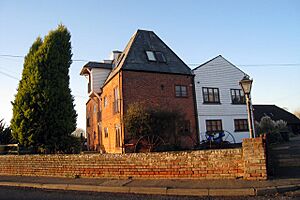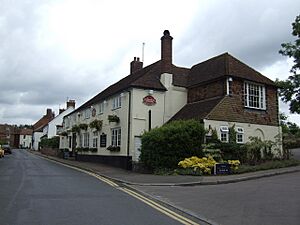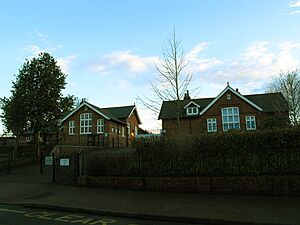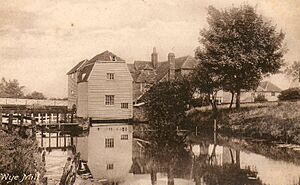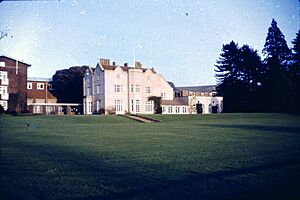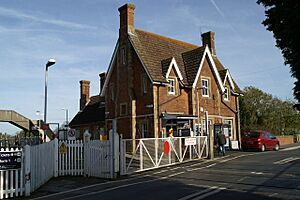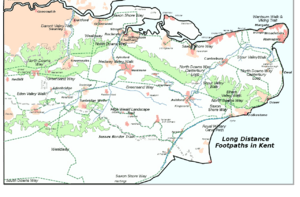Wye, Kent facts for kids
Quick facts for kids Wye |
|
|---|---|
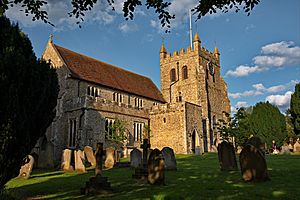 St Gregory and St Martin's Church, Wye |
|
| Area | 24.1 km2 (9.3 sq mi) |
| Population | 2,282 (Civil parish 2011) |
| • Density | 95/km2 (250/sq mi) |
| OS grid reference | TR055466 |
| Civil parish |
|
| District |
|
| Shire county | |
| Region | |
| Country | England |
| Sovereign state | United Kingdom |
| Post town | Ashford |
| Postcode district | TN25 |
| Dialling code | 01233 |
| Police | Kent |
| Fire | Kent |
| Ambulance | South East Coast |
| EU Parliament | South East England |
| UK Parliament |
|
Wye is a lovely village in Kent, England. It is part of the Wye with Hinxhill parish. Wye is about 5 miles (8 km) from Ashford and 12 miles (19 km) from Canterbury.
This village is famous for its special types of hops, like Wye Challenger. These hops were first grown at Wye College and named after the village. Wye also has a chalk pit. This pit used to be an outdoor theater. Now, it's a cool place for live music. A band called The Crowns has played over 100 concerts there!
In 2013, Sunday Times newspaper said Wye was the third best place to live in the UK.
Contents
- A Look at Wye's Past
- Wye's Beautiful Landscape
- Community Life in Wye
- Wye Farmers Market: Fresh Local Produce
- Wye Village Hall: A Community Hub
- Wye Library: A Place to Read
- Wye Church: Saint Gregory and Saint Martin
- Saint Ambrose Catholic Church
- Sports and Recreation in Wye
- Lady Joanna Thornhill School: A Primary School
- Wye School: A Secondary School
- Spring Grove School: An Independent School
- Famous Landmarks in Wye
- Getting Around Wye
- Famous People from Wye
- Wye's Civil Parish History
- See also
A Look at Wye's Past
The name "Wye" comes from an old English word, "Wēoh." This word means idol or shrine. People think Wye might have been a place of worship for the ancient Angles before Christianity arrived.
Wye became an important travel spot because of a ford. A ford is a shallow place to cross a river. This ford was over the River Great Stour. It connected Wye to old paths across the North Downs. The Romans built a road here between Canterbury and Hastings. They used the natural gap in the North Downs. Some people think the straight Olantigh Road was also built by Romans. It might have been a separate route from Wye to Canterbury. Remains of an ironworks from the Roman period have been found near the river. By the medieval times, Wye had a busy market. It also hosted the local court.
In 1798, a writer named Edward Hasted described Wye. He said it was a "neat well-built town." It had two main streets and two cross streets. He also mentioned a large village green. The church and college were close by.
Later in the 18th century, a turnpike road was built. This new road went around the village. The A28 road still follows this path today. Wye railway station opened on December 1, 1846. It was part of the railway line from Ashford to Margate.
RAF Wye: A World War I Airfield
During World War I, the Royal Flying Corps built an airfield near Wye Railway Station. It was called RAF Wye in 1918. But it closed just one year later. Today, this land is used for farming.
Wye Racecourse: Horse Racing History
The first horse race meeting at Wye Racecourse was in 1849. It took place in Fanscombe Valley. This valley is a natural outdoor theater north of Wye Crown. Flat racing happened every year on May 29, which was Oak Leaf Day. This day also matched the Wye Fair.
By 1878, horse racing in Wye moved to a new course on Harville Road. Steeplechase races were held there until 1974. The course closed for good by June 1975. Both of these old racecourses are now farmland.
Wye Court: A Royal Past
As early as the 6th century, Wye was a royal vill. This means the royal court would stay near Wye Court for part of the year. In the 13th century, it was a Royal Manor. The palace complex was at Wye Court.
Wye was important because it had the first ford over the River Stour. Travelers from the West Country could cross here on their way to Dover.
In 1307, King Edward II spent Christmas at Wye Court. This was after his father, King Edward I, died. Young King Henry VI visited Wye Court in 1428.
The Manor House at Wye Court was a large building. It had a round dungeon that was still there in the 1800s. People called it the Lollard's Hole.
Wye was affected by the Wat Tyler uprising in 1381 and Jack Cade's rebellion in 1450. In 1553, two Protestants were burned to death in front of Wye Church.
Queen Elizabeth I gave Wye Court to the Hunsden family. Later, it belonged to the Finches.
After a lightning strike at Wye Church in 1572, farmer Roger Twysden from Wye Court gave wood to rebuild the church tower.
In 1648, during the English Civil War, a small fight happened at the entrance to Wye Court.
By 1732, Wye Court was owned by a very rich man named John "Vulture" Hopkins. Later, it was sold to John Sawbridge.
Wye Court used to be much larger than the farm you see today. Wye College bought parts of Wye Court in 1925 to grow. In 1917, Wye Church bought some land from Wye Court to make its graveyard bigger.
The Entomologist Frederick Theobald lived at Wye Court until he died in 1930. He taught at the South Eastern Agricultural College. He also studied mosquitos and tropical health. His work earned him international awards.
In September 1940, a Spitfire plane crashed at Wye Court. The pilot was hurt, and the plane was destroyed. The crash site was dug up in 1974 by the RAF Museum.
Wye College: A Place of Learning
Wye College was started in 1447 by Cardinal Kempe. It was first a chantry (a religious foundation). From 1627, it was a grammar school. In 1894, the buildings became the South Eastern Agricultural College. It offered University of London degrees from 1898. In 1948, it officially became Wye College. It joined with Imperial College in 2000. However, the campus slowly closed between 2005 and 2009.
Imperial College's Plans for Wye
In 2005, Imperial College had a plan for Wye College. They wanted to use it for renewable fuel research. They also wanted to build 4,000 houses in the Kent Downs. Many people were against this plan. They saw it as a test case for building in Areas of Outstanding Natural Beauty. These are protected areas. In 2006, the local council stopped supporting the plan. Imperial College then dropped its ideas. People who wanted to protect the area were very happy.
Wye's Beautiful Landscape
Wye is in the Kent Downs Area of Outstanding Natural Beauty. It sits on the Great Stour. The river cuts through the North Downs here. The village is overlooked by the Wye Downs. This area has chalk hills and woods. It includes places like the Devil's Kneading Trough. These unique shapes were formed by ice age processes.
Community Life in Wye
Wye Farmers Market: Fresh Local Produce
51°11′00″N 0°56′17″E / 51.18329°N 0.93801°E A farmers' market is held in Wye. It's on The Green on the first and third Saturday of every month. It was started by Richard Boden, a former Wye College student. Usually, about 15 sellers are there. During the COVID-19 restrictions, the market even had an online shop!
Wye Village Hall: A Community Hub
51°11′02″N 0°55′56″E / 51.18379°N 0.932162°E
Wye Village Hall is on Bridge Street. It was renovated between 2014 and 2019. It has three rooms for events. The biggest room can hold up to 180 people.
Wye Library: A Place to Read
51°10′56″N 0°56′14″E / 51.18227°N 0.93728°E Wye Library is located at the top of Bridge Street.
Wye Church: Saint Gregory and Saint Martin
51°11′04″N 0°56′16″E / 51.18449°N 0.93791°E The main Anglican church in Wye is Saint Gregory and Saint Martin. It's a very old building, grade I listed. It was first built in 1290. It was much bigger than the church you see today. It had a longer nave and a larger chancel. The steeple had a tall wooden spire. Only the outer walls of the nave from this first church still stand.
In the 15th century, Cardinal Kempe rebuilt the church. He also built Wye College. The new church had beautiful windows and a strong roof.
In 1548, during the Reformation, images of saints were removed. In 1557, two Protestants were burned to death in front of Wye Church. This happened during the reign of Queen Mary.
In 1572, lightning struck the steeple and it burned. The lead covering the spire melted. Repairs were done, but the church was still in bad shape. This might have been because of an earthquake in 1580. More repairs were done in 1582 and 1584.
The church's "five great bells" were damaged in the 1572 fire. They were finally remade in 1593. Their weight added stress to the steeple. In 1628, the wooden spire was replaced again. But problems with the chancel and the risk of the steeple falling were not fixed.
On March 22, 1686, the steeple tower collapsed. Most of the church was destroyed. The beautiful windows and tombs were gone. Between 1700 and 1711, the church was rebuilt. It was made smaller than before. Charles Finch, 4th Earl of Winchilsea paid for the chancel. The rest was paid for by the parish. The new church was only about half the size of the old one.
Lady Joanna Thornhill, who the Lady Joanna Thornhill School is named after, died during this time. She was buried in the new church. She had helped pay for its rebuilding.
Since 2011, the vicar of Wye is Reverend Ravi Holy.
Saint Ambrose Catholic Church
51°10′54″N 0°56′15″E / 51.18153°N 0.93763°E Saint Ambrose Catholic Church is off Oxenturn Road. It was built in 1954. During World War II, Catholic services were held in Wye for the first time since the Reformation. This happened at Wye College's dining hall. Before the current church was built, an old stable was used as a chapel.
The church's pews came from an old church in Ashford. Two old benches might be from the 1700s.
Sports and Recreation in Wye
Wye Cricket Club plays at Horton Meadow. In 2014, they received a £2,000 grant.
Wye Tennis Club has five courts. They are at the Wye Village Hall recreation ground. The club started in 1971. By 2012, they had five courts with lights for night play.
Wye Juniors FC plays football at the old Wye College recreation ground. Their clubhouse was destroyed by a fire in 2022.
Lady Joanna Thornhill School: A Primary School
51°11′00″N 0°55′59″E / 51.18327°N 0.93292°E
Lady Joanna Thornhill Primary School is on Bridge Street. It is named after Lady Joanna Thornhill (1635–1708). She was the daughter of Sir Bevil Grenville. She was also a lady-in-waiting to Queen Catherine of Braganza. Lady Thornhill's will paid for a charity school in Wye in 1708. She is buried at Wye Church.
Her trust bought part of Cardinal Kempe's old buildings at Wye College. Boys and girls were taught in different rooms. The schoolmaster and mistress were paid from rent on properties.
However, the school's conditions were not good. An inspector in the 1800s said the facilities were "about the worst schools in the neighbourhood."
In 1892, the old school buildings were sold. They became the South Eastern Agricultural College. The school moved to its current location.
Today, Lady Joanna Thornhill School is run by The Care Foundation Trust.
| Edward Vincer | In office 1797 |
| William Adams | In office c. 1820, c. 1842 |
| Henry Holmes | 1855–1859 |
| John Herbert | Appointed 1859, in office 1862 |
Wye School: A Secondary School
Wye School is a mixed secondary school. It opened on Olantigh Road in 2013. It moved into new buildings in 2017. It includes parts of the former Wye College.
Spring Grove School: An Independent School
51°10′59″N 0°55′14″E / 51.18311°N 0.92069°E Spring Grove School is a private school on Harville Road. It is for boys and girls aged 2–11. It has a forest school on its 14-acre (5.7 ha) site.
The old mansion on the site was once home to famous people. These include author Joseph Conrad and politician Baroness Trumpington.
Famous Landmarks in Wye
Wye Bridge: Crossing the River Stour
51°11′05″N 0°55′49″E / 51.18474°N 0.93017°E The current bridge over the River Stour was built in 1638. It replaced an older wooden bridge. It has five stone arches over the river. There are also more arches between the river and the railway line. A stone plaque from 1683 is kept in the Church of Saint Gregory and Saint Martin.
A weir (a small dam) was built downstream of the bridge in 1962.
Wye Mill: An Old Water Mill
51°11′04″N 0°55′49″E / 51.184420°N 0.93040°E The 18th-century brick mill house and timber mill building are grade II listed. It was originally a water mill for grinding corn. Later, it was used for making animal feed. Today, it is a guest house.
Wye Crown: A Hill Figure
East of the village, you can see the Wye Crown. It's a huge hill figure cut into the chalk of the North Downs. Students from Wye College made it in 1902. They did this to celebrate the coronation of Edward VII. It is part of a special protected area called the Wye and Crundale Downs Site of Special Scientific Interest.
Olantigh: A Historic Estate
Olantigh has been home to several important families over the centuries.
Withersdane Hall: A Student Residence
In 2019, Imperial College sold Withersdane Hall. It was a former Wye College building. Now, a private university plans to use it for about 250 students.
Other Historic Buildings
As of 2022, there are 139 listed buildings in Wye with Hinxhill Parish. Some of these include:
| Building Name | Location | Listing Grade | Built in |
|---|---|---|---|
| Old Swan House | 134, Bridge Street | II* | 15th century |
| Old Flying Horse | 1, The Green | II* | 14th century |
| Old Manor House | 36, Church Street | II* | 16th century |
| Yew Trees | Scotton Street | II* | 17th century |
Getting Around Wye
Railway Station: Wye's Train Link
Until 2022, the gates at the level crossing near Wye railway station were opened and closed by hand. This could cause road closures for 10-15 minutes when trains passed. One local even made a phone app to help people know when the barrier was closed!
Walking Paths: Exploring the Countryside
Wye is on the southern route of the North Downs Way. This path crosses the Stour Valley Walk and follows the Pilgrims Way. These are great for hiking!
Cantii Way: A Cycling Adventure
The Cantii Way is a 145-mile (233 km) circular cycling route. It uses cycle paths, bridleways, and quiet roads. It starts and ends in Wye. Cycling UK launched this route in 2022. It was partly to celebrate the Platinum Jubilee of Elizabeth II.
The route also goes through Canterbury, Whitstable, Dungeness, Hythe, Tenterden, Folkestone, and Dover. It's named after the ancient Cantii people who used to live in this area.
Famous People from Wye
- Aphra Behn (1640–1689), a writer and spy
- Evelyn Mary Dunbar (1906–1960), an artist
- John Kemp (c. 1380–1454), a very important church leader and Lord Chancellor
- Bryan Keith-Lucas (1912–1996), a political scientist
- Catharine Macaulay (1731–1791), a historian
- Ernest Stanley Salmon (1871–1959), a hop breeder and tennis player
- Alex Loudon (born 1980), a cricketer
- Thomas Kempe (died 1489), a Bishop of London
- Thomas Brett (1667–1743), a clergyman and author
- Joseph Conrad (1857–1924), a famous author
- Charles Scudamore (1779–1849), a physician
- Robert Billing (1834–1898), a Bishop of Bedford
- Arthur Willink (1850–1913), a theologian and author
- John Richardson (born 1950), a Dean of Bradford
- John Sawbridge (1732–1795), a politician
- Samuel Elias Sawbridge (1769–1850), a politician
- John Erle-Drax (1800–1887), a landowner and politician
- Jacob Sawbridge (1665–1748), a banker and politician
- Mark Deller (born 1938), a conductor and singer
- Anne Finch, Countess of Winchilsea (1661–1720), a poet
- Heneage Finch, 5th Earl of Winchilsea (1657–1726), a nonjuror
- John Locke (1632–1704), a famous philosopher
- Caleb Banks (1659–1696), a politician
- Sir John Banks, 1st Baronet (1627–1699), a merchant and politician
- Ethel Gabain (1883–1950), an artist
- Tobias Boshell (born 1950), a musician
- Eve Billing (1923–2019), a plant scientist
- Jean Barker, Baroness Trumpington (1922–2018), a politician
- Frederick Vincent Theobald (1868–1930), an entomologist (insect expert)
Wye's Civil Parish History
In 1961, the Wye parish had 1989 people. On April 1, 1987, the parish was combined with Hinxhill. They now form the "Wye with Hinxhill" parish.
See also
 In Spanish: Wye para niños
In Spanish: Wye para niños


